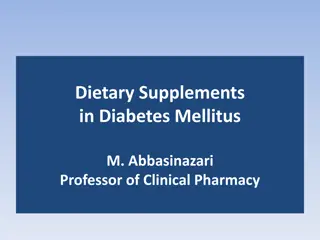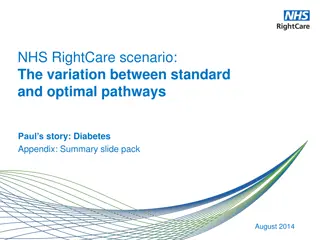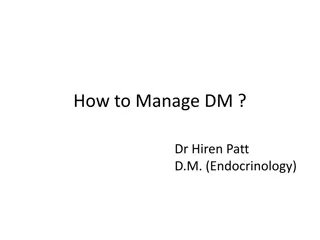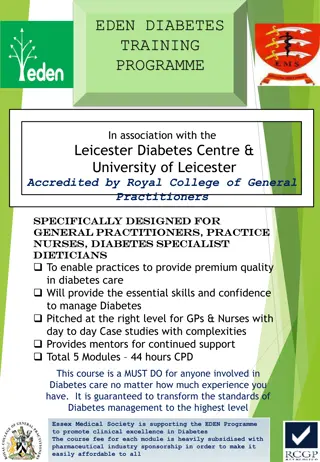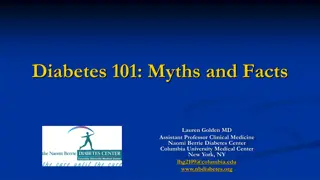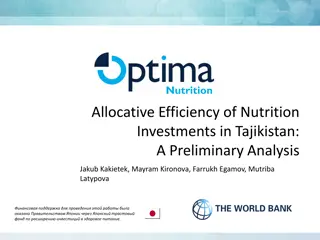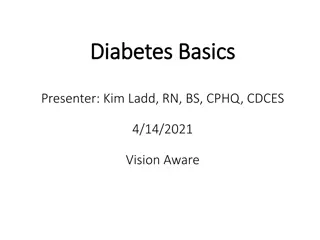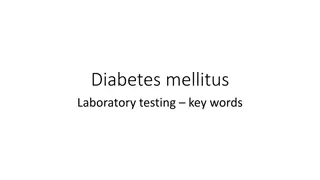
Optimal Nutrition for Diabetes Management
Understanding diabetes, its types, and the importance of a balanced diet with a low glycemic index for effective management. Learn about glycemic index and dietary advice for optimal nutrition for diabetes patients.
Uploaded on | 1 Views
Download Presentation

Please find below an Image/Link to download the presentation.
The content on the website is provided AS IS for your information and personal use only. It may not be sold, licensed, or shared on other websites without obtaining consent from the author. If you encounter any issues during the download, it is possible that the publisher has removed the file from their server.
You are allowed to download the files provided on this website for personal or commercial use, subject to the condition that they are used lawfully. All files are the property of their respective owners.
The content on the website is provided AS IS for your information and personal use only. It may not be sold, licensed, or shared on other websites without obtaining consent from the author.
E N D
Presentation Transcript
Dietary advice for optimal nutrition FOR DIABETES BY- Karthik and Pallavi
What is diabetes? Diabetes is a chronic condition that happens when your blood sugar (glucose) is too high. It develops when your pancreas doesn t make enough insulin or any at all, or when your body isn t responding to the effects of insulin properly.
Diabetes Mellitus The term is derived from greek words dia [through], bainein [ to go ] and diabetes literally means pass through. The greek word mellitus means sweet . Diabetes mellitus is metabolic disease due to absolute or relative insulin deficiency . It is common clinical condition. About 10% of total population, and 1/5th of persons above the age of 50, suffer from this disease. It is a major cause for morbidity and mortality. Insulin deficiency leads to increased blood glucose level. inspite of this high blood glucose, entry of glucose into the cell is inefficient.
Types of diabetes Type 1 diabetes: This type is an autoimmune disease in which your immune system attacks and destroys insulin-producing cells in your pancreas for unknown reasons. Up to 10% of people who have diabetes have Type 1. It s usually diagnosed in children and young adults, but it can develop at any age. Type 2 diabetes: With this type, your body doesn t make enough insulin and/or your body s cells don t respond normally to the insulin (insulin resistance). This is the most common type of diabetes. It mainly affects adults, but children can have it as well. Gestational diabetes: This type develops in some people during pregnancy. Gestational diabetes usually goes away after pregnancy. However, if you have gestational diabetes, you re at a higher risk of developing Type 2 diabetes later in life.
DIET FOR PATIENT WITH DIABETES This is the first line of treatment. A diabetic patient is advised to take a balanced diet with high protein, low calories, devoid of refined sugars and low Saturated fat, adequate PUFA, low cholesterol and sufficient quantities of fiber. Giving a diet having low glycemic index, so that elevation in blood sugar is minimal . Giving the total calories in small divided doses , so that small quantity of food is taken at frequent intervals.
Glycemic Index A glycemic index is a number from 0 to 100 assigned to a food with pure glucose given the value of 100 which represents the relative rise in the blood glucose level two hours after consuming that food . It is assessed by glucose tolerance test . Reference meal is taken as 50 g of glucose Index = Increment area under glucose tolerance curve after 50 g test meal x 100 Incremental area under curve after 50 g of reference meal ( glucose )
Recommended foods Healthy carbohydrates During digestion, sugars and starches break down into blood glucose. Sugars also are known as simple carbohydrates, and starches also are known as complex carbohydrates. Focus on healthy carbohydrates, such as: Fruits. Vegetables. Whole grains. Legumes, such as beans and peas. Low-fat dairy products, such as milk and cheese. Avoid less healthy carbohydrates, such as foods or drinks with added fats, sugars and sodium.
Fiber-rich foods Dietary fiber includes all parts of plant foods that your body can't digest or absorb. Fiber moderates how your body digests food and helps control blood sugar levels. Foods high in fiber include: Vegetables. Fruits. Nuts. Legumes, such as beans and peas. Whole grains. Heart-healthy fish Eat heart-healthy fish at least twice a week. Fish such as salmon, mackerel, tuna and sardines are rich in omega-3 fatty acids. These omega-3s may prevent heart disease.
'Good' fats Foods containing monounsaturated and polyunsaturated fats can help lower your cholesterol levels. These include: Avocados. Nuts. Canola, olive and peanut oils. But don't overdo it, as all fats are high in calories.
Foods to avoid Saturated fats. Avoid high-fat dairy products and animal proteins such as butter, beef, hot dogs, sausage and bacon. Limit coconut and palm kernel oils. Trans fats. Avoid trans fats found in processed snacks, baked goods, shortening and stick margarines. Cholesterol. Cholesterol sources include high-fat dairy products and high-fat animal proteins, egg yolks, liver, and other organ meats. Aim for no more than 200 milligrams (mg) of cholesterol a day. Sodium. Aim for no more than 2,300 mg of sodium a day. Your health care provider may suggest you aim for a smaller amount if you have high blood pressure.
What are the results of this kind of diet? Embracing a healthy-eating plan is the best way to keep your blood sugar level under control and prevent diabetes complications. And if you need to lose weight, you can tailor the plan to your specific goals. Aside from managing your diabetes, a healthy diet offers other benefits too. Because this diet recommends generous amounts of fruits, vegetables and fiber, following it is likely to lower your risk of cardiovascular diseases and certain types of cancer. And eating low-fat dairy products can reduce your risk of low bone mass in the future.








